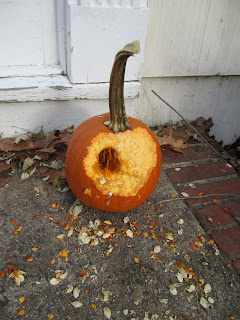This is really going too far. Our beloved trash can, which for years had stood proudly in the driveway in as pristine a condition as any trash can could long remain, has been defaced. Or should I say that it has been given a face, though a bit lacking in symmetry.
What neighborhood elements would target this modest, unassuming, yet as aforementioned proud, container that had served so well for so long? Now its shield from the elements lays scattered in bits on the pavement, spit out like watermelon seeds.
We immediately secured the services of an ace detective, who wasted no time in tracking down past acts of vandalism that bore an uncanny resemblance to this most recent act. The circular hole shifted leftward in a broad swath of gnawings, the scattered debris--clearly we were looking not at an isolated attack but instead the work of a repeat offender, for whom the type of material was immaterial.
A survey of neighborhood trash cans on collection day revealed that the problem went well beyond our driveway.
I began wondering not why we had been targeted, but how our trash can had eluded this perpetrator for so long. Could it be because we compost vegetable scraps, and thereby reduce the aromatic incentives for breakins?
As with any research, questions proliferated faster than we could answer them. Is this the work of one individual, a gang marking its territory, or might there be a broad mammalian alliance extending across Princeton and beyond, dedicated to saving landfill space by shining light on all the useful stuff we throw away?
Can any can withstand the demands of this brand of animal? One remained untouched, perhaps because its diminutive stature conveys to all its owner's strong waste-reduction ethic, and teeth are as yet no match for metal.







No comments:
Post a Comment